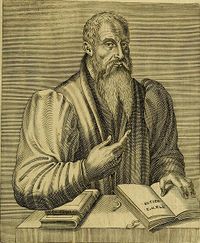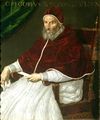Category:Enochic Studies--1500s
Enochic Studies in the 1500s--Works and Authors
< ... -- 1400s -- 1500s -- 1600s -- 1700s -- 1800s -- 1850s -- 1900s -- 1910s -- 1920s -- 1930s -- 1940s -- 1950s -- 1960s -- 1970s -- 1980s -- 1990s -- 2000s -- 2010s -- ... >
Overview
"Christian Cabalists" continued to be the frontrunners in the search for the "lost" book(s) of Enoch. Johannes Reuchlin was well acquainted with the cultural activities at the Hospitium fratrum Indianorum established in Rome in 1481. He was in correspondence with Johannes Potken who in 1513 co-edited with the Ethiopian friar Thomas Walda Samuel the first book ever printed in Ethiopic (Alphabetum seu potius syllabarium literarum Chaldaerarum, Rome, 1513). Yet no major progress was accomplished concerning the book of Enoch. In De arte cabalistica (1517) Reuchlin still implied that Pico had it as one of the "seventy secret books of Ezra," ignoring that Pico had instead only a Hebrew ms (and Latin translation) of Menahem Recanati's work, of which the editio princeps was published in 1523 and a commentary by Mordecai Jaffe appeared in 1595.
The figure of Enoch remained popular in esoteric circles all around Europe. In 1530 the Venetian alchemist Giovanni Agostino Panteo published 26 charachters purporting to be the pre-Flood "Enochian" alphabet. The "rediscovery" of this alphabet was not the result of philological studies but of magical knowledge; after all, as Hermetic author Zosimos of Panopolis wrote in the 3rd-4th century, the art of alchemy was believed to be at the core of the ancient pre-deluge science. It was one of the secret knowledges taught by the fallen angels and inscribed after the Flood in the Book of Chemes, who was identified with Cam, the son of Noah and descendent of Enoch.
Expectations of the "return" of Enoch continued to be very strong in millenaristic circles. In 1524, Martin Luther himself had to intervene to disprove these beliefs in his commentary on the Letter to Jude. The most notable incident occurred in 1533-34; after Melchior Hofmann predicted that Christ would return to earth, the anabaptist Jan Matthys ruled the city of Munster, Germany as the "New Jerusalem," declaring that he was the prophet Enoch redivivus. Matthys died during the siege of the city, when on Easter Sunday made a sally forth with thirty followers, convinced that Judgment Day had come.
In the meantime, the relations between Europa and Ethiopia had become closer and Ethiopia gradually abandoned its traditional isolationism. When Portuguese diplomat and explorer Pêro da Covilhã arrived in Ethiopia in 1490, he was allowed to stay but not to leave the country. In 1520, however, a Portuguese embassy was welcomed for a visit and diplomatic relations were established between Ethiopia and Portugal. The embassy's chaplain Francisco Alvares composed the first description of the country, then published in Portuguese (Lisbon, 1540) and Italian. The Hospitium fratrum Indianorum in Rome also benefitted from the arrival of Ethiopian pilgrims and scholars. From 1537 to 1552, Tasfa Seyon, known as Peter the Indian, edited in Rome the first printed edition of the New Testament in Ge’ez, the Ethiopian liturgical language. Thanks to the its authority was definitively established in the 15th century as a result of the reform of Emperor Zar'a Ya'qob, who made it a centerpiece in his apologetical interaction with Judaism. The earliest mss of 1 Enoch date from that period.
First evidence of the existence of an actual book of Enoch in Ethiopia came in mid-16th century by French Christian Cabalist Guillaume Postel. Thanks to the reform of Emperor Zar'a Ya'qob in the 15th century, the book of Enoch had gained a more solid canonical status in Ethiopia and numerous new manuscripts had been produced. Not accidentally this was also the time in which the news of the existence of the Book of Enoch in Ethiopia also reached Europe. In 1551 in De Etruriae regionis Guillaume declared that the Enoch's prophesies made before the Flood were preserved in the archives of the Queen of Sheba and that to this day they were believed to be canonical scripture in Ethiopia. In 1553 he wrote in his De originibus that in Rome (most likely, in 1547) he had met an Abyssinian priest (apparently, Tasfa Seyon) who illustrated him the content of 1 Enoch. Postel's piece of information was included in 1559 by British playwright John Bale in his popular work on Scriptorum Illustrium maioris Brytanniae posterior pars (Basel 1559). According to Luis de Urreta, the Librarian of the Vatican Apostolic Library Guglielmo Sirleto also was made aware of the existence of the Book of Enoch in Ethiopia by two friers who visited the country (in 1579?) as members of a delegation sent by Pope Gregory XIII to the Ethiopian King. By the mid-16th cent. the connection between Enoch and Ethiopia was thus firmly established, but no progress was made in the recovery of the actual text of the book of Enoch.
The idea that magic and alchemy could provide a shortcut continued to fascinate European intellectual circles. In his Introductio in divinam Chemiae artem (Basel 1572) Petrus Bonus repeated Roger Bacon's remarks that Henoch was the great Hermogenes. News from Postel and Bale about the existence of the Book of Enoch (and the frustration about the lack of progress in its recovery) inspired British alchemist John Dee to follow the same path as Panteo and Petrus Bonus. In May 1581 some promising yet inconclusive experiments with the crystal ball convinced Dee that he needed the services of a professional scryer to communicate with the spirits. In 1582-83 Dee formed a partnership with visionary Edward Kelley in the search for the lost wisdom of Enoch. The result was the "discovery" of a mysterious alphabet they claimed to have received from the archangel Michael, and portions of the Book of Enoch written in the "Enochian language" they believed Enoch himself used to communicate with the angels.
@2014, Gabriele Boccaccini, University of Michigan
Pages in category "Enochic Studies--1500s"
The following 20 pages are in this category, out of 20 total.
1
- Orlando furioso (The Frenzy of Orlando / 1516 Ariosto), Italian poem
- De arte cabalistica (1517 Reuchlin), book
- Testamenta duodecim patriarcharum filiorum Jacob (1520 Grosseteste), book
- פירוש על התורה (Commentary to the Torah / 1523 Recanati), book (Hebrew / ed. princeps)
- Die ander Epistel S. Petri und eyne S. Judas (1524 Luther), book
- De harmonia mundi totīus cantica tria (1525 Zorzi), book
- Commentarii in Epistolas catholicas (1527 Lefèvre), book
- Voarchadumia contra alchimiam (1530 Panteo), book
- Pentagruel et Gargantua (1532-34 Rabelais), novel
- An Exposition vpon the Epistle of Jude ye Apostle of Christ (1549 Ridley), book
- Commentaria in omnes divi Pauli, et alias septem canonicas epistola (1551 Pellicanus), book
- De Etruriae regionis (1551 Postel), book
- De originibus seu de varia ... Latino incognita historia totius Orientis (1553 Postel), book
- Scriptorum illustrium maioris Brytanniae posterior pars (1559 Bale), book
- The Testaments of the Twelve Patriarchs, the Sonnes of Jacob (1574 Gilby), book
- Vite dei santi e beati del sacro ordine dei frati predicatori (1577 Razzi), book
- Liber mysteriorum (1583 Dee, Kelley), ms
- לבוש מלכות (Robes of Royalty / 1595 Jaffe), book (Hebrew)









